
Matchless 1901-67 and 1987 UK
Cycle maker Harry H Collier established himself at Herbert Road, Plumstead, London, and was later joined by sons Harry and Charlie to form H Collier and Sons. They began experimenting with motorcycles in 1899, first with the engine mounted over the front wheel, then behind the saddle tube followed by under the steering head to pedal crank tube, which was used on their first production model in 1901. Coining the name Matchless, they soon adopted the Werner engine position and were on their way to become one of the most successful UK factories over the next six decades.
The enthusiasm of the young Collier brothers for motorcycling and competition was immense and, although they briefly entered car production with a tricar c1904, motorcycles were their life. The younger Colliers excelled in motorcycle sport with Charlie winning two IoM TTs (1907 and 1910), Harry one in 1909, plus three more top three places between them. They were regular winners at cycle tracks, especially Canning Town and Crystal Palace, recording many Brooklands wins, records and in head to heads with rival crack riders of the period. This roller coaster of sporting success set Matchless up as a leading factory but they made enemies, especially among rival Brooklands riders! However, the Collier-de-Rosier Match Race series of 1911 must have been a highlight, won by the American’s 994cc Indian two-to-one, pitted against Charlie Collier’s 998cc Matchless JAP, the big V-twins thundering along high on the Brooklands banking at 80mph. A few days later Collier hit back, posting new flying kilometre and mile records at over 91mph.
Against this background of competition and development, Matchless built a range of above average motorcycles for the market place, including singles and V-twins with side or overhead valves and by 1912, a six-speed variable gear system intended for sport but also available on roadsters. The Colliers and JAP co-operated on engine design, including in 1912 a 496cc ohv V-twin weighing a mere 46lb. At the same time Matchless built, albeit on JAP lines, their first engine, an 85.5 x 85mm single.
Whether because the design was unsound or perhaps the approaching war dictated policy changes, by WWI they’d dropped all smaller models to concentrate on a range of three 8hp V-twins, including the Swiss MAG ioe engined 8B with fully enclosed chain drive, three-speed countershaft gearbox, kick starter and internal expanding drum rear brake. The 8B/w had interchangeable wheels too. Despite listing a military model, Plumstead received no worthwhile orders and the plant, noted for its engineering quality, was given over to munitions and aircraft spares production when the government ended all civilian motorcycle manufacture in 1916.
Returning to civilian motorcycle manufacture in 1919, Colliers continued with a range of big V-twins including the 8B/2 (renamed Victory) and the Model H outfit, a revised 8B/2 with swinging arm frame and electric lighting. In 1923, the Matchless transfer reappeared on a single, the L2, with 348cc Blackburne engine and three-speed Sturmey Archer gearbox. Soon, they were listed as making their own engines often with the assistance of external specialists. In short order, 591cc singles and 347cc ohc singles – a concept intended for TT racing – joined the range.
 By 1925, Matchless had developed their own 990cc V-twin engine and a year later were also building the 246cc side-valve Model R, their first post WWI under 250cc lightweight. Company founder Harry H Collier died in 1926, then the business went public two years later as Matchless Motor Cycles (Colliers) Ltd. While the firm had gained a deserved reputation for sporting prowess before WWI, this shifted to one of building worthy, well engineered motorcycles of conservative design. Suddenly this all changed. At the 1929 London Show, Plumstead broke form, unveiling the side-valve 400cc narrow angle V-twin Silver Arrow and a year later the ohc 593cc narrow angle V-four Silver Hawk.
By 1925, Matchless had developed their own 990cc V-twin engine and a year later were also building the 246cc side-valve Model R, their first post WWI under 250cc lightweight. Company founder Harry H Collier died in 1926, then the business went public two years later as Matchless Motor Cycles (Colliers) Ltd. While the firm had gained a deserved reputation for sporting prowess before WWI, this shifted to one of building worthy, well engineered motorcycles of conservative design. Suddenly this all changed. At the 1929 London Show, Plumstead broke form, unveiling the side-valve 400cc narrow angle V-twin Silver Arrow and a year later the ohc 593cc narrow angle V-four Silver Hawk.
They displayed advanced thinking, but the buying public weren’t ready for such sophistication and sales were slow. The depression didn’t help. However, the Colliers’ prudent housekeeping enabled Matchless to outbid BSA for the apparently ailing AJS company of Wolverhampton. Hindsight tells us AJS was still a viable business, but period bankers thought otherwise! The operation was moved to Plumstead, and AJS production resumed alongside Matchless after a short break.
Initially, the Colliers planned for the two marques to retain individual identities but, by 1935, business economics dictated otherwise and, for many models, badge engineering was the keyword. After the Silver Arrow and Hawk, tax dodging models pared down to under 224lb and the sloping engine phase, Plumstead settled on a range of 250-500cc singles and the sturdy Model X V-twin range. Nothing technically outlandish, but good worthy well made models which went and sold well, ensuring sound financial health and solid reputation at Plumstead as WWII loomed.
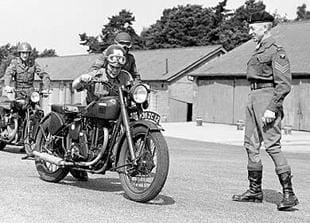 The rights to Sunbeam were acquired and, in 1938, the company name was changed to Associated Motor Cycles Ltd. (AMC). While design advances weren’t world shattering, Plumstead did hone their models, especially the ohv singles, to near perfection, including hairpin valve springs. Rival makers, including OEC, sought Matchless power. Many AJS and Matchless models were now near indistinguishable, apart from logos and in some cases the mounting position of the magneto (behind engine for Matchless, in front for AJS).
The rights to Sunbeam were acquired and, in 1938, the company name was changed to Associated Motor Cycles Ltd. (AMC). While design advances weren’t world shattering, Plumstead did hone their models, especially the ohv singles, to near perfection, including hairpin valve springs. Rival makers, including OEC, sought Matchless power. Many AJS and Matchless models were now near indistinguishable, apart from logos and in some cases the mounting position of the magneto (behind engine for Matchless, in front for AJS).
Plumstead began supplying small numbers of their ohv 347cc G3 Clubman to the military in 1935; first an evaluation model, then in small numbers between 1936-39. Although there were early concerns regarding reliability of wheel bearings, sprockets and gearboxes, by WWII the military were happy. By late 1940, over 18,000 girder forked G3s had been purchased by the forces who still wanted a lighter machine. Matchless set to and then iced the cake by fitting their newly developed Teledraulic front fork (hydraulically damped telescopic fork). Coded the G3L, a couple of prototypes were offered to the military in late 1940 for evaluation, followed by over 60,000 service models.
During WWII, the Sunbeam marque was sold to BSA and Harry Collier died in 1944, leaving Charlie as sole surviving founder. AfterWWII, Matchless wisely developed their G3L into civilian guise, first 350cc, then a 500cc roadster, followed in short order by competition models, all of which – with updates – survived into the Sixties. For many years, AMC was one of Britain’s leading off-road competition factories. Leading Matchless riders inclded Artie Ratcliffe, Ted Usher, Basil Hall, Brian Stonebridge, Dave Curtis and Chris Horsfield.
Following fashion, Matchless unveiled a parallel twin, the 498cc G9 in 1948, which later grew to 592cc (G11), then 646cc (G12) and finally 745cc (G15). The distinctive AMC full width hub appeared in 1954, a useful recognition point, the same year Charlie (Mr Charlie) Collier died.
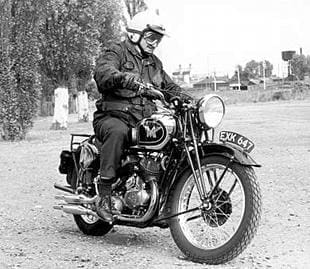 Despite the runaway racing success of the Collier brothers in the pre-WWI days and later clubman efforts using modified roadsters, Matchless avoided factory support again until the launch of the G45 in 1952. A sweeping statement which doesn’t tell the whole story as factory AJS racers appeared in the Thirties, the Porcupine after WWII and my all time favourite the 7R in 1948. Developed from the G9, the G45 got off to a good start with a fourth for Robin Sherry in the 1951 Senior MGP and a win for Derek Farrant a year later.
Despite the runaway racing success of the Collier brothers in the pre-WWI days and later clubman efforts using modified roadsters, Matchless avoided factory support again until the launch of the G45 in 1952. A sweeping statement which doesn’t tell the whole story as factory AJS racers appeared in the Thirties, the Porcupine after WWII and my all time favourite the 7R in 1948. Developed from the G9, the G45 got off to a good start with a fourth for Robin Sherry in the 1951 Senior MGP and a win for Derek Farrant a year later.
Strangely, after the early promise, the G45 failed to achieve the same success again and the following G50 single enjoyed a strange career.
Folklore tells us that AMC Sales Director and former road racer Jock West, disappointed with the G45s record, floated the idea of a stretched AJS 7R. With engineering expertise including that of Jack Williams the G50 evolved with a 90mm bore barrel grafted onto a 7R bottom end with modified 7R cylinder head. Much of the rest was stock or modified 7R.
They displayed advanced thinking, but the buying public weren’t ready for such sophistication and sales were slow. The depression didn’t help. However, the Colliers’ prudent housekeeping enabled Matchless to outbid BSA for the apparently ailing AJS company of Wolverhampton. Hindsight tells us AJS was still a viable business, but period bankers thought otherwise! The operation was moved to Plumstead, and AJS production resumed alongside Matchless after a short break.
Initially, the Colliers planned for the two marques to retain individual identities but, by 1935, business economics dictated otherwise and, for many models, badge engineering was the keyword. After the Silver Arrow and Hawk, tax dodging models pared down to under 224lb and the sloping engine phase, Plumstead settled on a range of 250-500cc singles and the sturdy Model X V-twin range. Nothing technically outlandish, but good worthy well made models which went and sold well, ensuring sound financial health and solid reputation at Plumstead as WWII loomed.
The rights to Sunbeam were acquired and, in 1938, the company name was changed to Associated Motor Cycles Ltd. (AMC). While design advances weren’t world shattering, Plumstead did hone their models, especially the ohv singles, to near perfection, including hairpin valve springs. Rival makers, including OEC, sought Matchless power. Many AJS and Matchless models were now near indistinguishable, apart from logos and in some cases the mounting position of the magneto (behind engine for Matchless, in front for AJS).
Plumstead began supplying small numbers of their ohv 347cc G3 Clubman to the military in 1935; first an evaluation model, then in small numbers between 1936-39. Although there were early concerns regarding reliability of wheel bearings, sprockets and gearboxes, by WWII the military were happy. By late 1940, over 18,000 girder forked G3s had been purchased by the forces who still wanted a lighter machine. Matchless set to and then iced the cake by fitting their newly developed Teledraulic front fork (hydraulically damped telescopic fork). Coded the G3L, a couple of prototypes were offered to the military in late 1940 for evaluation, followed by over 60,000 service models.
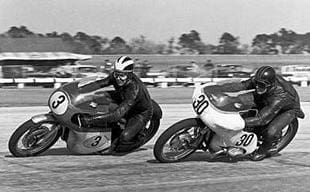 During WWII, the Sunbeam marque was sold to BSA and Harry Collier died in 1944, leaving Charlie as sole surviving founder. AfterWWII, Matchless wisely developed their G3L into civilian guise, first 350cc, then a 500cc roadster, followed in short order by competition models, all of which – with updates – survived into the Sixties. For many years, AMC was one of Britain’s leading off-road competition factories. Leading Matchless riders included Artie Ratcliffe, Ted Usher, Basil Hall, Brian Stonebridge, Dave Curtis and Chris Horsfield.
During WWII, the Sunbeam marque was sold to BSA and Harry Collier died in 1944, leaving Charlie as sole surviving founder. AfterWWII, Matchless wisely developed their G3L into civilian guise, first 350cc, then a 500cc roadster, followed in short order by competition models, all of which – with updates – survived into the Sixties. For many years, AMC was one of Britain’s leading off-road competition factories. Leading Matchless riders included Artie Ratcliffe, Ted Usher, Basil Hall, Brian Stonebridge, Dave Curtis and Chris Horsfield.
Following fashion, Matchless unveiled a parallel twin, the 498cc G9 in 1948, which later grew to 592cc (G11), then 646cc (G12) and finally 745cc (G15). The distinctive AMC full width hub appeared in 1954, a useful recognition point, the same year Charlie (Mr Charlie) Collier died.
Despite the runaway racing success of the Collier brothers in the pre-WWI days and later clubman efforts using modified roadsters, Matchless avoided factory support again until the launch of the G45 in 1952. A sweeping statement which doesn’t tell the whole story as factory AJS racers appeared in the Thirties, the Porcupine after WWII and my all time favourite the 7R in 1948. Developed from the G9, the G45 got off to a good start with a fourth for Robin Sherry in the 1951 Senior MGP and a win for Derek Farrant a year later.
Strangely, after the early promise, the G45 failed to achieve the same success again and the following G50 single enjoyed a strange career.
Folklore tells us that AMC Sales Director and former road racer Jock West, disappointed with the G45s record, floated the idea of a stretched AJS 7R. With engineering expertise including that of Jack Williams the G50 evolved with a 90mm bore barrel grafted onto a 7R bottom end with modified 7R cylinder head. Much of the rest was stock or modified 7R.
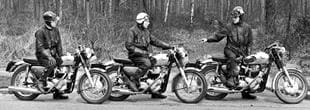 Initial tests were promising and the G50 was marketed 1958/9 until 1962, by which time about 180 had been sold, plus another 25 with lighting kit as the G50CSR to America – a requirement to allow the model to race at Daytona. So what’s so strange? Simply that the best years of the G50 began two years after AMC had stopped building it. Fred Stevens was third in the 1964 Senior TT behind Mike Hailwood’s MV and Derek Minter’s Norton, with fellow G50 riders Derek Woodman fourth and William McCosh sixth. During that season, nine Matchless riders scored world championship points astride G50s, including Phil Read and Mike Duff, plus Selwyn Griffiths won the year’s Senior MGP. But perhaps it’s not that strange, as tuner/entrants like Tom Arter, Ray Cowles and Colin Seeley – who also successfully raced a G50 outfit – could do marvellous things with the single’s engine and gearbox.
Initial tests were promising and the G50 was marketed 1958/9 until 1962, by which time about 180 had been sold, plus another 25 with lighting kit as the G50CSR to America – a requirement to allow the model to race at Daytona. So what’s so strange? Simply that the best years of the G50 began two years after AMC had stopped building it. Fred Stevens was third in the 1964 Senior TT behind Mike Hailwood’s MV and Derek Minter’s Norton, with fellow G50 riders Derek Woodman fourth and William McCosh sixth. During that season, nine Matchless riders scored world championship points astride G50s, including Phil Read and Mike Duff, plus Selwyn Griffiths won the year’s Senior MGP. But perhaps it’s not that strange, as tuner/entrants like Tom Arter, Ray Cowles and Colin Seeley – who also successfully raced a G50 outfit – could do marvellous things with the single’s engine and gearbox.
Sadly, by 1960, AMC were struggling. Company brands Matchless, AJS, James and Francis Barnett were perceived old fashioned in some quarters, the Japanese invasion was round the corner and the ‘lightweight’ 250/350cc unit construction models wouldn’t save the day. As AMC folded, Manganese Bronze Holdings, under the chairmanship of Dennis Poore, stepped in. Norton/Matchless hybrids were to survive a little longer, but the launch of the Norton Commando effectively ended all that. AJS resurfaced as two-stroke scramblers while the Matchless logo appeared briefly once more in 1987 on a 494cc Rotax engined single built by Les Williams.
Matchless, like AJS, make an excellent entry level classic or an ideal motorcycle for the hardened enthusiast. Backed by an excellent club with superb spares scheme and enthusiastic dealers, they offer the joy of riding archetypical British machines. NB there are many second-hand as well as new post-AMC G50s available which is healthy so long as the buyer is aware of the original source of the machine.
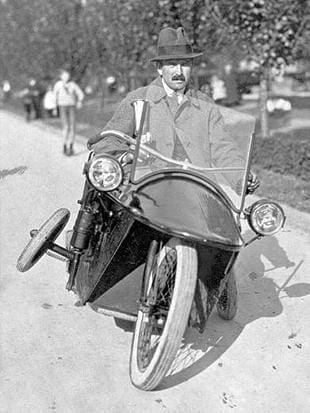 Mauser 1924-27 (32) Germany
Mauser 1924-27 (32) Germany
One of the strangest devices included in this guide but a little piece of history worth noting. Without much demand for their armaments, Mauserwerke of Obernauf am Neckar entered the automotive world with a single track two-wheeler car-like vehicle with outrigger stabilisers, which some claim were retractable. Powered by a softly tuned 510cc single cylinder side-valve engine it was slow, as were sales. Mauserwerke ended production in 1927 but Gustav Winkler of the same town continued building the two-wheeled car until 1932. The French firm Monotrace built the Mauser under licence.
MBM 1974-81 Italy
Small 50cc scooters, mopeds and lightweights built at Cesna, Italy. Odd models surface cheaply.
MCB (Monark Crescent Bolaget) 1902-c1975 Sweden
Intermittent manufacture of motorcycles by firm who over the years swallowed many rivals including Hermes, Apollo and Monark. During their main period of production (1960-75) they built lightweights with 48-123cc Sachs and Morini two-stroke engines.
McEvoy 1926(1924)-c1929 UK
Although featuring frames designed by Michael McEvoy, the marque was originally claimed to be under the ownership of LF Ellis, Duffield Cottage, Duffield near Derby. However, Michael McEvoy, the son of a successful Victorian portrait painter, was still working as an apprentice for Rolls-Royce and, on leaving their employ, took over the reins of his motorcycle business. Then the mystery deepens for, although the majority of sources claim McEvoy was not established until 1926, Michael was competing on a 1000cc McEvoy in Brooklands events as early as 1924.
Aided by George Patchett and financed by Cecil Birkin, as well as his own inheritance, Michael wanted to build quality machines like Brough Superior, but with even more performance. This led to the top of the range, fast, ohv British Anzani engined twins. Smaller models with Villiers two-stroke and Blackburne single cylinder engines were built as well as JAP single and V-twin models. Cecil Birkin, the brother of Tim – one of the famed ‘Bentley Boys’ – was killed practising for the 1927 IoM TT. He was the last rider to be killed while practising on open roads, after which the roads comprising the Mountain Circuit were closed to traffic for practice. Following Birkin’s death, McEvoy began to struggle financially, ending motorcycle manufacture with a batch of speedway models in 1929. Michael McEvoy went on to to recoup his wealth by becoming UK representative for Zoller superchargers and then became a high ranking engineering officer during WWII.
Ownership of an ohv V-twin McEvoy is not for the faint hearted. Think Brough Superior prices and minimal spares availability. But weigh this against the joy of owning a 45-plus hp vintage motorcycle with 100-plus mph top speed. And if you want even more, fit a supercharger, like Michael McEvoy did!
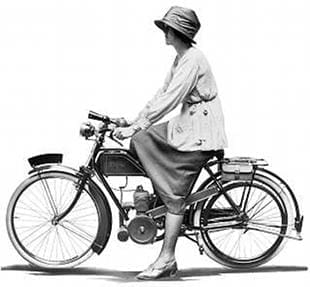 McKenzie 1921-25 UK
McKenzie 1921-25 UK
Ultra-lightweight 170cc two-stroke built by Hobart of Coventry for McKenzie, Shaftsbury Avenue, London. Many were direct drive pedal start models with dropped frame for ladies with long skirts. However, diamond frames were an option and later gearboxes. Pleasant early vintage lightweight but don’t expect to find many spares.
MDS c1955-60 Italy
Small 65-80cc ohv single cylinder motorcycles and a 65cc scooter built by the Scoccimaro Brothers in Milan. I have seen odd modestly priced examples at continental autojumbles but as yet never in the UK.
Mead Cycle Company 1938-c1953 USA
Established in 1889 by the Mead family in Chicago, they built cycles including the Ranger and were often involved in trade battles with Chicago rivals Schwinn. After Schwinn launched the Whizzer engine, Mead contracted Moto-Scoot manufacturer Norman Siegal to built basic model Moto-Scoots badged as the Mead Ranger. With redesigns, the model continued until the early Fifties.
Megola 1921-25 Germany
So many superlatives, negative and positive, have been written about the Megola. As unfeasible as the concept may seem, the Megola works. In fact, it works jolly well and is a highly prized enthusiast’s piece, ideal for the track-based timed trials where the rider sets their own pace for the first lap then endeavours to equal that time on each subsequent lap. Riders of the Megola simply set the throttle, steer an identical course for each lap and the evenrunning radial five cylinder side-valve engine sited in the front wheel does the rest.
Founded as Mego in 1920 by Teilhaber Meixer and well known motorcycle engineer Fritz Cockerill, the Munich firm became Megola Motoren Aktiengesellschaft in 1921 when joined by Landgraf.
The name Megola is derived from the first two letters of the surname of each of the three partners; Cockerill changed the spelling of his surname to Gockerill for this purpose!
 Around 2000 639cc Megolas with direct drive, reduced via fixed ratio planetary gears were built. The engine was housed within the front wheel, which was spoked to enable cylinders to be removed without unlacing the wheel. The frame was of welded and riveted pressed steel construction, with leaf sprung front forks. Survival rate is moderate, but this highly prized motorcycle is only for those with deep pockets.
Around 2000 639cc Megolas with direct drive, reduced via fixed ratio planetary gears were built. The engine was housed within the front wheel, which was spoked to enable cylinders to be removed without unlacing the wheel. The frame was of welded and riveted pressed steel construction, with leaf sprung front forks. Survival rate is moderate, but this highly prized motorcycle is only for those with deep pockets.
Meguro 1937-64 Japan
Company established in 1924 to manufacture parts for the Japanese motorcycle and automotive industries who, in 1937, began building complete motorcycles using British motorcycles as their inspiration. During WWII, Meguro supplied a limited number of machines to the Japanese military and, after the war, continued building single and later parallel twin cylinder, motorcycles, again based on British design.
Meguro are noted for their copy of the BSA A7/A10 ohv parallel twin which was built in capacities of up to 650cc. During the Fifties links were created between Meguro and Kawasaki leading to a legally binding association in 1960 and full merger in 1961. The BSA A7 clone Meguro K2 formed the base of the Kawasaki W1. A number of Meguros and limited spares have been imported into Europe and are sought after by Japanese enthusiasts.



